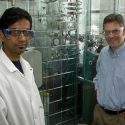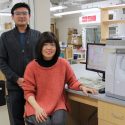With 400th Ph.D. grad, UW-Madison celebrates a half century of fusion energy
In the 1930s and ’40s, many researchers studied ways to use fusion, the reaction in which atomic nuclei collide, fuse and release energy, to develop atomic weapons. Later, those same brilliant minds began to focus on beneficial applications of fusion, including developing plants that would produce electrical energy for society.

Kulcinski
Noted physicist Don Kerst was among those researchers. During World War II, Kerst had worked on the Manhattan Project, which produced the first atomic bomb, at Los Alamos National Laboratory. However, when he joined the University of Wisconsin–Madison faculty in 1963, he began a strong, broad and enduring tradition of plasma and fusion research and graduate education at the university.
The program today is among the largest and most widely respected university programs in the United States, says Gerald Kulcinski, the UW–Madison Grainger Professor of Nuclear Engineering. Fusion-related research at UW–Madison now spans three departments in two colleges; includes more than 150 faculty, staff and students; and covers a range of theoretical, experimental and technological aspects of plasma science and fusion. Since the 1960s, fusion-related research in the UW–Madison departments of physics, electrical and computer engineering, and engineering physics has garnered more than $100 million in funding.
In 2012, the UW–Madison fusion community marked a major milestone with the graduation of its 400th fusion-related Ph.D. student. “All major fusion institutions in the world know that a UW grad student has received training second to none — whether in theory, computation or experiment,” says Stewart Prager, director of the Princeton Plasma Physics Laboratory (PPPL) and a former UW–Madison professor of physics. “A graduate student in computation will work on the most advanced code, a grad student in experiment will have hands-on experience in the most modern of facilities, a fusion technology student will work on cutting-edge futuristic fusion issues.”
Harold Forsen and Robert Conn, former professors of nuclear engineering, and John Scharer, a professor emeritus of electrical and computer engineering, were among the first UW–Madison engineering fusion faculty in the mid-1960s. Gil Emmert, a professor emeritus of engineering physics, came to UW–Madison in 1968. At the time, he says, the fusion program was primarily experimental. “People were optimistic that fusion power was just around the corner,” he says. “The fusion program at that time was almost all experimental, with only a small amount of theory and essentially nothing dealing with the engineering problems of fusion power,” he says.
Now, UW–Madison strengths include non-fusion plasma science in plasma astrophysics and plasma-aided manufacturing, a cross-disciplinary theory and computation effort, and magnetic-confinement fusion. “We have more non-tokamak magnetic fusion devices on one site than anywhere,” says Kulcinski, who joined UW–Madison as a nuclear engineering faculty member in 1971, when the Fusion Technology Institute was founded at the university.
“Other university programs are deep in a specific area. Our program has been very broad: plasma physics, materials, neutronics, magnets, lasers, targets, economics.”
That breadth is a boon for graduate students, who don’t always know exactly what they want to study when they join the program, says Kulcinski. “They can change their focus without losing any credits,” he says. “They can discover their passion without having a specific research interest at the outset.”
In addition to campus-based research, UW–Madison faculty, staff and students also play major roles in national and international experiments such as ITER, the International Thermonuclear Experimental Reactor, and with colleagues at national laboratories. Those experiences present students the opportunity to broaden their UW–Madison fusion education and gain experience working in those settings.
UW-Madison alumni have a strong presence at all major national laboratories, says Prager. “I often notice, when I am in a room of scientific leaders at PPPL, that I am surrounded by Wisconsin people — those who have passed through UW as grad students, undergrads, postdocs or research staff,” he says.
At PPPL, the deputy director for research, program director of the major experimental facility NSTX, and stellarator physics division head all are UW–Madison alumni, as is the former deputy director of PPPL. Several of the rising stars at PPPL are UW grads, too, says Prager. The head of the PPPL plasma astrophysics program and recent faculty hire at Princeton University was a UW postdoc. The head of the major innovative experiment, the Lithium Tokamak Experiment, was a UW research staff member. “The list goes on and on,” he says. “Anyone who passes through the UW fusion program is the better for it.”
The story is the same at other national labs, where UW–Madison fusion alumni fill both key research and leadership ranks. Thomas Hunter, for example, who earned master’s and Ph.D. degrees in nuclear engineering in 1976 and 1978, recently retired as president of Sandia National Laboratories, while Steven Zinkle, who received bachelor’s, master’s and Ph.D. degrees in nuclear engineering in 1980, 1982 and 1985 (as well as a master’s degree in materials science in 1985), is the Oak Ridge National Laboratory nuclear science and engineering directorate chief scientist. The National Academy of Engineering named him a member in 2012.
UW fusion graduates also take high-level leadership positions in academia, government and industry, or become entrepreneurs. “Students aren’t here just preparing to clone the faculty,” says Kulcinski. “Our students are spread out geographically and in their positions.”
Nasr Ghoniem, for example, earned master’s and Ph.D. degrees in nuclear engineering in 1975 and 1977 and now is a distinguished professor in mechanical and aerospace engineering and materials science and engineering at the University of California, Los Angeles. Sam Zenobia, who earned master’s and Ph.D. degrees in nuclear engineering and engineering physics in 2007 and 2010, is a research analyst at the Center for Naval Analysis in Washington, D.C. And Greg Piefer, who earned bachelor’s degrees in electrical engineering and physics in 1999, and master’s and Ph.D. degrees in nuclear engineering and engineering physics in 2004 and 2006, founded Shine Medical Technologies, a Monona, Wis., company that will manufacture four important medical isotopes without the need for a nuclear reactor.
Piefer credits the UW–Madison fusion faculty for instilling in him and other graduate students the “secrets” of professional success. In Piefer’s case, it was building a business around nuclear fusion, then reinvesting the profits to improve the technology. “The goal is appealing because it would be game-changing for the world, but the path is also appealing because a route was provided to get there from the technology where it’s at today,” says Piefer. “Jerry [Kulcinski] also taught professionalism, work ethic and respect by example. I’m not sure if he does it on purpose or not, but he is an amazing role model.”



